Arcata is a city adjacent to the Arcata Bay (northern) portion of Humboldt Bay in Humboldt County, California, United States. Take a look below for 30 fascinating and fun facts about Arcata, California, United States.
1. At the 2020 census, Arcata’s population was 18,857.
2. Arcata was first settled in 1850 as Union, was officially established in 1858, and was renamed Arcata in 1860.
3. It is located 280 miles (450 km) north of San Francisco (via Highway 101), and is home to Humboldt State University. Arcata is also the location of the Arcata Field Office of the Federal Bureau of Land Management, which is responsible for the administration of natural resources, lands and mineral programs, including the Headwaters Forest, on approximately 200,000 acres (810 km2) of public land in Northwestern California.
4. The Wiyot people and Yurok people inhabited this area prior to the arrival of Europeans, and continue to live in the area. “Kori” is the name for the Wiyot settlement that existed on the site of what would become Arcata.
5. The name “Arcata” comes from the Yurok term oket’oh, meaning “where there is a lagoon” (referring to Humboldt Bay), from o-, “place”, plus ket’oh, “to be a lagoon”.
6. The same name was also used by the Yuroks for Big Lagoon.
7. The natives of this region are the farthest-southwest people whose language has Algic roots, a language family shared with the Algonquian.
8. The traditional homeland of the Wiyot ranged from the Little River in the north and continues south through Humboldt Bay (including the present cities of Eureka and Arcata) and then south to the lower Eel River basin.
9. The traditional homeland of the Yurok ranges from Mad River to beyond the Klamath River in the north. Today, Arcata is the headquarters of the Big Lagoon Rancheria tribe, who maintain a 20-acre (81,000 m2) reservation close by. Local Indian tribes operate several casinos in the area.
10. In a coordinated 1860 massacre, significant numbers of Wiyot people were killed at several locations in and around Humboldt Bay, including the center of their society, the island known to them as Duluwat Island.

11. A local newspaper editor, who would later be known as Bret Harte, was forced to leave the Humboldt Bay area after he editorialized his disgust with the incident.
12. The Spaniards claimed the area but never settled it; the first permanent settlements occurred after California was admitted to the Union.
13. Arcata was first settled as Union in 1850. Union was created as a port, and reprovisioning center for the gold mines in the Klamath, Trinity, and Salmon mountains to the east, and was very briefly the county seat during this period. It was slightly closer to the mines than Eureka, which gave Union an early advantage.
14. What was to become the first significant town on Humboldt Bay began as Union Company employees laid out the plaza and first city streets in the Spring of 1850.
15. By later in the 1850s redwood timber replaced the depleted gold fields as the economic driver for the region and Eureka became the principal city on the bay due to its possession of the better harbor, gaining it the county seat by the end of the decade.
16. The Union town post office opened in 1852, and the town changed its name to Arcata in 1860.
17. In 1886, concern over the growing number of unassimilated immigrants led Arcata to expel its Chinese population and enact the following resolution: “We, the citizens of Arcata and vicinity, wish the total expulsion of the Chinese from our midst. We endorse the efforts of Eureka to exclude all Chinese settlements in the city and environs.”
18. History and images of early settler families in Arcata is cataloged in the Susie Baker Fountain Paper and True Hoyle Collection at Humboldt State University.
19. These collections also include images of important social events in the Arcata area, such as graduations at Arcata High School as early as 1910, as well as images of social gatherings at the Arcata plaza before the Statue of William McKinley (Arcata, California) was erected in the center from 1906 until its relocation in 2019.
20. In August 1989, the voters of Arcata passed the Nuclear Weapons Free Zone Act, prohibiting work on nuclear weapons, and the storage or transportation of nuclear weapons within the City Limits.

21. The ordinance also minimized the city’s contracts for and purchases of the products and services of nuclear weapons contractors. On March 17, 2010, the Arcata city council voted for final passage of a Unlawful Panhandling ordinance (Ordinance No. 1399). Among other restrictions, it forbids panhandling within 20 feet (6.1 m) of any business.
22. The heart of Arcata is the Plaza. In the 1850s the Plaza was where goods destined for the Trinity County mines were loaded onto mule trains. The Plaza has a green lawn, extensive flower plantings, and at its center there used to be a statue of president William McKinley by Haig Patigian.
23. The Plaza is surrounded by bookstores, bars, coffee shops, restaurants, and live music venues.
24. The Plaza is also the center of Humboldt County’s largest farmers’ market (April through November), and serves as a major venue for local Fourth of July festivities, the Arcata Main Street Oyster Festival, the start of the Kinetic Sculpture Race, and the North Country Fair. The North Country Fair Samba Parade has been a community favorite since 1986.
25. The Plaza is also a popular rendezvous point for travelers who stop off in Arcata.
26. The annual Explorations in Afro-Cuban Dance and Drum workshop is held every summer on the HSU campus. The workshop hosts the largest assemblage of Afro-Cuban folkloric music and dance masters in the United States.
27. The statue of William McKinley has been a point of controversy since the 1970s.
28. Opponents of the statue condemned McKinley’s supposed support of settler colonialism and policies that led to the slaughter of Native Americans.
29. Supporters of the statue emphasized its historical significance as a major part of the culture of Arcata. In February 2018, the Arcata City Council voted to remove the statue from the Plaza, a decision supported in November 2018 when a referendum to block the statue’s removal was defeated.
30. In February 2019, the Arcata City Council approved a measure to relocate the statue to the William McKinley Presidential Library and Museum in Canton, Ohio, and on February 28, the statue was removed from the Plaza in preparation for its relocation.




